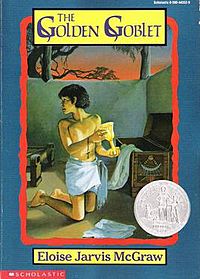The Golden Goblet facts for kids
 |
|
| Author | Eloise Jarvis McGraw |
|---|---|
| Genre | Children's Novel, Historical Fiction |
| Publisher | Coward McCann, Inc. |
|
Publication date
|
1961 |
| Pages | 248 |
| ISBN | 0-14-030335-9 |
| OCLC | 13064566 |
| LC Class | PZ7.M1696 Go 1986 |
The Golden Goblet is an exciting historical novel for young readers. It was written by Eloise Jarvis McGraw and first came out in 1961. The book even won a special award called the Newbery Honor in 1962! This story takes place in ancient Egypt, around 1400 B.C. It follows a brave young boy named Ranofer as he tries to uncover a secret crime and change his life for the better.
Contents
Unraveling the Mystery: The Story of Ranofer
Ranofer is a 12-year-old orphan in ancient Egypt. His mother passed away when he was born. His father, Thutra, was a skilled goldsmith. Ranofer learned a lot from him. After his father died, Ranofer had to live with his older half-brother, Gebu. Gebu treats Ranofer very badly. Without Gebu, Ranofer would have nowhere to go.
A Secret in the Goldsmith Shop
Ranofer's father knew Zau, a famous master goldsmith. Ranofer dreams of becoming Zau's apprentice. But he is stuck with Gebu. Gebu works in a goldsmith shop. Ranofer notices that gold dust is missing. He realizes that Ibni, a porter, is secretly taking gold. Ibni hides the gold in wineskins. Ranofer unknowingly carries these wineskins home.
Ranofer tries to stop this secret gold smuggling. But Gebu forces him to continue. Gebu threatens to harm Ranofer. He also threatens to sell him into slavery.
New Friends and New Clues
Ranofer soon makes two new friends. They are an old man called the Ancient and a boy named Heqet. Things get worse for Ranofer. Ibni is caught stealing. Gebu then moves Ranofer to his stone-cutting shop. Ranofer becomes an apprentice there. He hates this new job. It is not his dream of working with Zau.
With his friends' help, Ranofer suspects more stealing. He thinks someone else is taking gold at night. Heqet suggests they work together. They decide to spy on Gebu and his friends. They meet secretly by the river. They share food and talk about what they've heard. This happens during Ranofer's break from his difficult job.
The Golden Goblet and a Pharaoh's Secret
Ranofer sneaks into Gebu's room. He finds a beautiful golden goblet there. This goblet looks very old and special. Ranofer sees markings on it. They show the name of a pharaoh, Thutmose the Conqueror. Ranofer realizes Gebu has been robbing tombs! He knows Gebu could not get so rich so quickly otherwise.
Ranofer asks the Ancient how tomb robbers are caught. The Ancient tells him, "They must be followed." Heqet overhears Gebu's plans. Gebu will go on another tomb-robbing trip. This will happen during an upcoming feast. Ranofer keeps his discovery a secret.
Catching the Robbers
Ranofer follows Gebu to a burial chamber. Meanwhile, Heqet and the Ancient also go to the Valley of the Kings. They put clues together. They figure out where Ranofer has gone. Ranofer puts out the robbers' torch inside the tomb. A giant step crumbles. This traps Gebu and his partner, Wenamon.
Ranofer places a large boulder over the entrance. Then he finds Heqet and the Ancient. They sit on the boulder to keep the robbers trapped. Ranofer rushes back to town. He manages to get into the palace. He tries to see the queen. Palace guards stop him at first. Qa-nefer, the queen's dwarf, believes Ranofer's story.
Ranofer finally gets to speak with the queen. He tells her about the golden goblet. He mentions Thutmose's name on it. The queen decides to test his honesty. She asks him about her parents' burial chamber. Ranofer answers correctly. He tells her about her father's staff. The queen immediately sends soldiers. They catch Gebu and Wenamon.
A New Beginning for Ranofer
The queen asks Ranofer what he wants most. "A donkey," Ranofer says. He wants to earn a living like the Ancient. He also wants to be Zau the Gold Master's student. And he wishes to make beautiful jewelry for the queen. The book ends with Ranofer riding his new donkey. He meets with the Ancient and Heqet. Ranofer has truly changed his life.
Ancient Egypt in the Story
The Golden Goblet is a historical novel. This means it mixes a made-up story with real history. We don't know much about the daily lives of Egyptian artisans. But some historical events can be connected to the book.
Tombs and Discoveries
The tomb of Thutmose the Conqueror was robbed. This happened about 200 years before the time of the novel. In 1905, the tomb of Yuya and Tuya was found. This tomb had been entered by robbers. But most of its treasures were still inside. The person who found it, James Quibell, thought the robbers might have been scared away. This real-life event gives the novel a cool historical feeling.
What is a Newbery Honor?
The Golden Goblet was given a Newbery Honor award. This award is very special for children's books. The Newbery Medal is given each year to the best American children's book. The Newbery Honor is for books that are runners-up. These are books that are also excellent. The Newbery Honor award was officially started in 1971. Books like The Golden Goblet that were great runners-up before 1971 were then given this honor.

